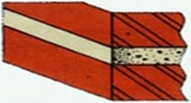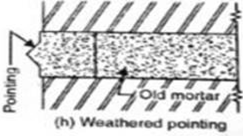This set of Civil Engineering Drawing Quiz focuses on “Analysis of Rates of Plastering and Pointing”.
1. __________ is a building material used for the protective and/or decorative coating of walls and ceilings and for moulding and casting decorative elements.
a) Cement
b) Aggregate
c) Plaster
d) Paint
View Answer
Explanation: The most common types of plaster mainly contain either gypsum, lime, or cement, but all work in a similar way. The plaster is manufactured as a dry powder and is mixed with water to form a stiff but workable paste immediately before it is applied to the surface. The reaction with water liberates heat through crystallization and the hydrated plaster then hardens.
2. __________ plaster is a mixture of clay, sand and water with the addition of plant fibers for tensile strength over wood lath.
a) Loam
b) Sand
c) Gypsum
d) Clay
View Answer
Explanation: Clay plaster has been used since antiquity. Settlers in the American colonies used clay plaster on the interiors of their houses: “Interior plastering in the form of clay antedated even the building of houses of frame, and must have been visible in the inside of wattle filling in those earliest frame houses in which …wainscot had not been indulged.
3. Gypsum plaster, or plaster of Paris, is produced by heating __________ to about 300 °F.
a) gypsum
b) clinker
c) calcium
d) lime
View Answer
Explanation: CaSO4•2H2O + heat → CaSO4•0.5H2O + 1.5H2O (released as steam).
When the dry plaster powder is mixed with water, it re-forms into gypsum. The setting of unmodified plaster starts about 10 minutes after mixing and is complete in about 45 minutes; but not fully set for 72 hour. If plaster or gypsum is heated above 266 °F (130 °C), hemihydrate is formed, which will also re-form as gypsum if mixed with water.
4. Lime plaster is a mixture of calcium hydroxide and sand (or other inert fillers).
a) True
b) False
View Answer
Explanation: Lime plaster was a common building material for wall surfaces in a process known as lath and plaster, whereby a series of wooden strips on a studwork frame was covered with a semi-dry plaster that hardened into a surface. The plaster used in most lath and plaster construction was mainly lime plaster, with a cure time of about a month.
5. To make lime plaster, limestone (calcium carbonate) is heated above approximately 50 °C to produce quicklime.
a) True
b) False
View Answer
Explanation: To make lime plaster, limestone (calcium carbonate) is heated above approximately 850 °C to produce quicklime. Water is then added to produce slaked lime (calcium hydroxide), which is sold as a wet putty or a white powder. Additional water is added to form a paste prior to use. The paste may be stored in airtight containers.
6. The following figure is a rubbed, keyed or grooved type of pointing.

a) True
b) False
View Answer
Explanation: This pointing is also a modification of flush pointing in which groove is formed at its mid height, by a pointing tool. It gives good appearance.
7. Heat resistant plaster is a building material used for coating walls and chimney breasts.
a) True
b) False
View Answer
Explanation: Its purpose is to replace conventional gypsum plasters in cases where the temperature can get too high for gypsum plaster to stay on the wall. Heat resistant plaster should be used in cases where the wall is likely to exceed temperatures of 50 °C.
8. Cracks in plastering may be caused by settlement of the building, by the use of inferior materials or by bad workmanship.
a) True
b) False
View Answer
Explanation: However, due to none of these, cracks may yet ensue by the too fast drying of the work, caused through the laying of plaster on dry walls which suck from the composition the moisture required to enable it to set, by the application of external heat or the heat of the sun, by the laying of a coat upon one which has not properly set, the cracking in this case being caused by unequal contraction, or by the use of too small a proportion of sand.
9. Instead of plastering entire surface of the masonry, special mortar finishing work is done to the exposed joints. This is called pointing.
a) True
b) False
View Answer
Explanation: It consists of raking the joints to a depth of 10 mm to 20 mm and filling it with richer mortar mixes. In case of lime mortar pointing mix used is 1:2 and in case of cement mortar pointing mix used is 1:3. Pointing is ideally suited for stone masonry because stones are having attractive colours and good resistance to penetration by water.
10. One differentiates between interior and exterior fireproofing. Exterior products are typically less substantial, with lower densities and lower cost. Interior products have to withstand more extreme fire and other environmental conditions.
a) True
b) False
View Answer
Explanation: One differentiates between interior and exterior fireproofing. Interior products are typically less substantial, with lower densities and lower cost. Exterior products have to withstand more extreme fire and other environmental conditions.
11. Laths are about an inch wide, and are made in three thicknesses; single (5 to 6 inch thick), lath and a half (4 inch thick), and double (3–5 inch thick).
a) True
b) False
View Answer
Explanation: Laths are about an inch wide, and are made in three thicknesses; single (\(\frac{1}{8}\) to \(\frac{3}{16}\) inch thick), lath and a half (\(\frac{1}{4}\) inch thick), and double (\(\frac{3}{8}\)–\(\frac{1}{2}\) inch thick).
12. Cement plaster is a mixture of suitable plaster, sand _____________ and water.
a) fine aggregate
b) portland cement
c) cement
d) plaster
View Answer
Explanation: It is normally applied to masonry interiors and exteriors to achieve a smooth surface. Interior surfaces sometimes receive a final layer of gypsum plaster. Walls constructed with stock bricks are normally plastered while face brick walls are not plastered. Various cement-based plasters are also used as proprietary spray fireproofing products.
13. Name the type of pointing, where mortar is pressed hard in the raked joints and by finishing off flush with the edge of masonry units. The edges are neatly trimmed with trowel and straight edge.
a) Struck pointing
b) V-pointing
c) Weathered pointing
d) Flush pointing
View Answer
Explanation: It does not give good appearance. But, flush pointing is more durable because of resisting the provision of space for dust, water etc., due to this reason, flush pointing is extensively used.

14. The below figure shows ___________

a) struck pointing
b) v-pointing
c) weathered pointing
d) beaded pointing
View Answer
Explanation: It is a special type of pointing which is formed by a steel or ironed with a concave edge. It gives good appearance, but it will damage easily when compared to other types.
15. _________ pointing is made by making a projection in the form of V-shape.
a) V-pointing
b) Struck pointing
c) Weathered pointing
d) Surface pointing
View Answer
Explanation: This type of pointing is made similar to keyed or grooved pointing by suitably shaping the end of the steel rod to be used for forming the groove. V pointing pointing is formed by forming v-groove in the flush finishing face.

Sanfoundry Global Education & Learning Series – Civil Engineering Drawing.
To practice all areas of Civil Engineering Drawing for Quizzes, here is complete set of 1000+ Multiple Choice Questions and Answers.
If you find a mistake in question / option / answer, kindly take a screenshot and email to [email protected]
- Check Civil Engineering Drawing Books
- Practice Civil Engineering MCQs
- Check Civil Engineering Books
- Apply for Civil Engineering Internship
